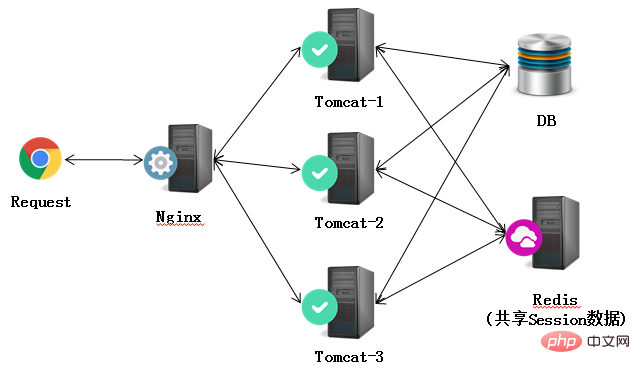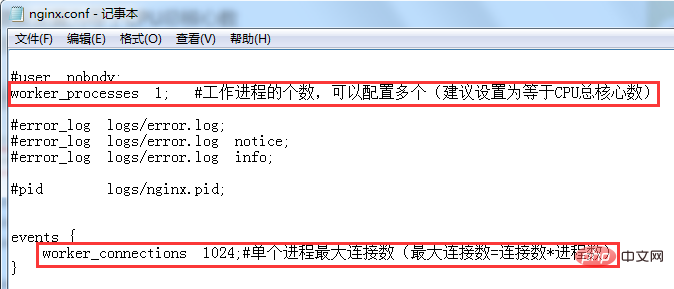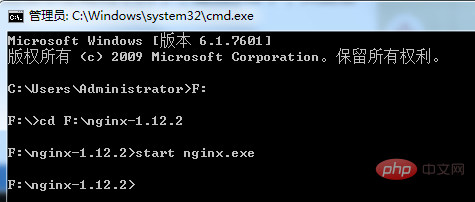 Operation and Maintenance
Operation and Maintenance
 Nginx
Nginx
 How to build a high-performance load balancing cluster of Nginx+Tomcat
How to build a high-performance load balancing cluster of Nginx+Tomcat
How to build a high-performance load balancing cluster of Nginx+Tomcat
nginx is a high-performance http server/reverse proxy server and email (imap/pop3) proxy server. It occupies less memory, has strong concurrency capabilities, and performs better among web servers of the same type. nginx can be compiled and run on most unix linux os, and there is a windows ported version. In general, for new sites, it is recommended to use the latest stable version as the production version.
The maximum number of online visits supported by a single tomcat is about 500. To support more visits, one tomcat cannot do it. Here we use cluster deployment, use multiple tomcats, and use nginx as the reverse proxy.
The architecture is as follows:

Preparation work
apache-tomcat-7.0.61
nginx-1.12.2
redis-x64-3.2.100
To simplify the example, here we only talk about the deployment and integration of nginx tomcat.
nginx installation
(1) Go to the official website to download the latest stable version of nigx for windows (I use version 1.12.2).
(2) Unzip to any directory on the disk. Here I unzip it in f:\nginx-1.12.2
(3) Start the service: start nginx.exe
Stop the service: nginx -s stop
Reload the configuration : nginx -s reload
Modify nginx.conf
1. Number of processes and the maximum number of connections per process
nginx process number, it is recommended to set it equal to the total number of cpu cores
The maximum number of connections for a single process. Then the maximum number of connections to the server = number of connections * number of processes

2. Basic configuration of nginx
The listening port is generally the http port: 80
There can be multiple domain names, separated by spaces. For example, server_name www.sohu.com baidu,com

- location / {}: What kind of suffix is required for load balancing? If we want to load balance all files with aspx suffix, we can write like this: location ~.*\.aspx${}
- proxy_pass: Requests are directed to a custom server list. Here we redirect all requests to the load balancing server list identified as http://joannayan.com.
- weight weight, the higher the weight, the greater the chance of being assigned. The weight can be defined based on the machine configuration (if a server's hardware configuration is very good and can handle more requests, then a higher weight can be set for it; and if a server's hardware configuration is poor, then the previous weight can be set. The weight configuration of one unit is weight=2, and the weight configuration of the latter unit is weight=1).

Test
Deploy the testnginx.war web project to the tomcat servers of the two machines respectively (In order to distinguish that different web servers are accessed, the testnginx project deployed in the two machines has slightly different page display). Start tomcat on both machines and start nginx.


The above is the detailed content of How to build a high-performance load balancing cluster of Nginx+Tomcat. For more information, please follow other related articles on the PHP Chinese website!

Hot AI Tools

Undresser.AI Undress
AI-powered app for creating realistic nude photos

AI Clothes Remover
Online AI tool for removing clothes from photos.

Undress AI Tool
Undress images for free

Clothoff.io
AI clothes remover

Video Face Swap
Swap faces in any video effortlessly with our completely free AI face swap tool!

Hot Article

Hot Tools

Notepad++7.3.1
Easy-to-use and free code editor

SublimeText3 Chinese version
Chinese version, very easy to use

Zend Studio 13.0.1
Powerful PHP integrated development environment

Dreamweaver CS6
Visual web development tools

SublimeText3 Mac version
God-level code editing software (SublimeText3)

Hot Topics
 1675
1675
 14
14
 1429
1429
 52
52
 1333
1333
 25
25
 1278
1278
 29
29
 1257
1257
 24
24
 How to configure nginx in Windows
Apr 14, 2025 pm 12:57 PM
How to configure nginx in Windows
Apr 14, 2025 pm 12:57 PM
How to configure Nginx in Windows? Install Nginx and create a virtual host configuration. Modify the main configuration file and include the virtual host configuration. Start or reload Nginx. Test the configuration and view the website. Selectively enable SSL and configure SSL certificates. Selectively set the firewall to allow port 80 and 443 traffic.
 How to start containers by docker
Apr 15, 2025 pm 12:27 PM
How to start containers by docker
Apr 15, 2025 pm 12:27 PM
Docker container startup steps: Pull the container image: Run "docker pull [mirror name]". Create a container: Use "docker create [options] [mirror name] [commands and parameters]". Start the container: Execute "docker start [Container name or ID]". Check container status: Verify that the container is running with "docker ps".
 How to check the name of the docker container
Apr 15, 2025 pm 12:21 PM
How to check the name of the docker container
Apr 15, 2025 pm 12:21 PM
You can query the Docker container name by following the steps: List all containers (docker ps). Filter the container list (using the grep command). Gets the container name (located in the "NAMES" column).
 How to check whether nginx is started
Apr 14, 2025 pm 01:03 PM
How to check whether nginx is started
Apr 14, 2025 pm 01:03 PM
How to confirm whether Nginx is started: 1. Use the command line: systemctl status nginx (Linux/Unix), netstat -ano | findstr 80 (Windows); 2. Check whether port 80 is open; 3. Check the Nginx startup message in the system log; 4. Use third-party tools, such as Nagios, Zabbix, and Icinga.
 How to create containers for docker
Apr 15, 2025 pm 12:18 PM
How to create containers for docker
Apr 15, 2025 pm 12:18 PM
Create a container in Docker: 1. Pull the image: docker pull [mirror name] 2. Create a container: docker run [Options] [mirror name] [Command] 3. Start the container: docker start [Container name]
 How to check nginx version
Apr 14, 2025 am 11:57 AM
How to check nginx version
Apr 14, 2025 am 11:57 AM
The methods that can query the Nginx version are: use the nginx -v command; view the version directive in the nginx.conf file; open the Nginx error page and view the page title.
 How to configure cloud server domain name in nginx
Apr 14, 2025 pm 12:18 PM
How to configure cloud server domain name in nginx
Apr 14, 2025 pm 12:18 PM
How to configure an Nginx domain name on a cloud server: Create an A record pointing to the public IP address of the cloud server. Add virtual host blocks in the Nginx configuration file, specifying the listening port, domain name, and website root directory. Restart Nginx to apply the changes. Access the domain name test configuration. Other notes: Install the SSL certificate to enable HTTPS, ensure that the firewall allows port 80 traffic, and wait for DNS resolution to take effect.
 What to do if nginx server is hung
Apr 14, 2025 am 11:42 AM
What to do if nginx server is hung
Apr 14, 2025 am 11:42 AM
When the Nginx server goes down, you can perform the following troubleshooting steps: Check that the nginx process is running. View the error log for error messages. Check the syntax of nginx configuration. Make sure nginx has the permissions you need to access the file. Check file descriptor to open limits. Confirm that nginx is listening on the correct port. Add firewall rules to allow nginx traffic. Check reverse proxy settings, including backend server availability. For further assistance, please contact technical support.



